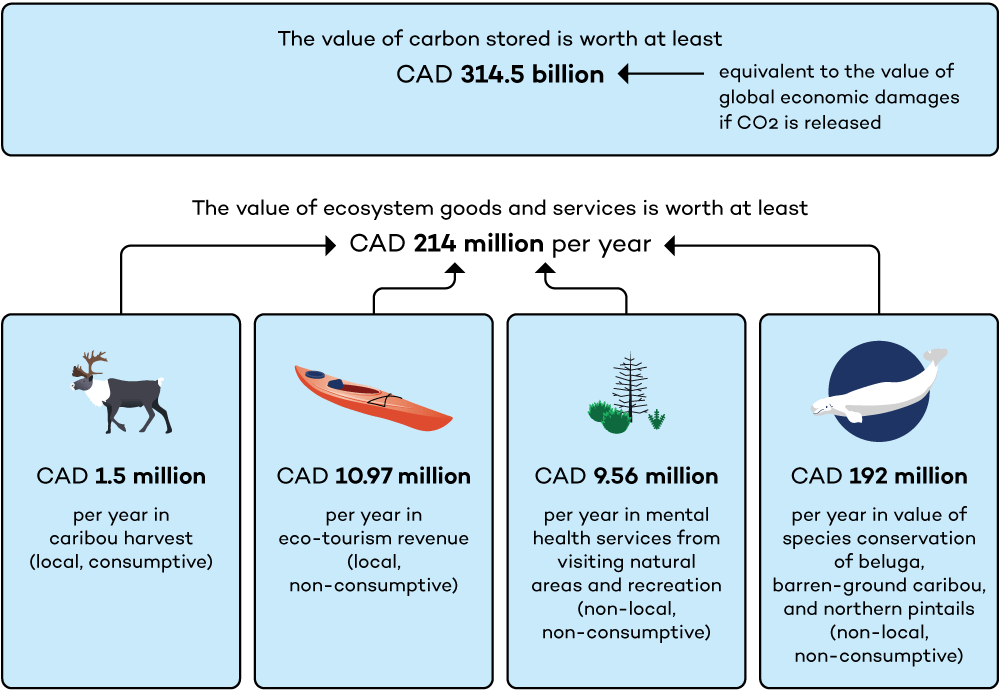
A Value on the Priceless: Ecological goods and services generated in the Seal River Watershed
This report assesses the economic value of ecosystem benefits provided by the Seal River Watershed, a large pristine region located in Northern Manitoba, Canada. The Seal River Watershed is not impacted by dams, industrial development, or forestry. It maintains clean water, is home to abundant wildlife, and supports the livelihoods and culture of Dene, Cree, and Inuit people. To stop and reverse global biodiversity loss and limit climate warming, it is critical to protect the world's last remaining intact regions like the Seal River Watershed.
-
The Seal River Watershed provides at minimum CAD 214 million worth of ecosystem goods and services annually.
-
The importance and value of ecosystem goods and services provided by the Seal River Watershed will increase as we are faced with the global decline of intact forest ecosystems and the global decline in biodiversity, which reinforces the need for its protection.
-
A fully functioning, ecologically intact watershed that is sustainably managed and monitored by Indigenous stewards will help contribute to our action on climate mitigation, resiliency, and biodiversity conservation.
Articulating the values of intact regions in monetary terms is one way to demonstrate how they benefit local and global communities. Economic valuations inform decision-makers and help strengthen the case for conservation. They also identify data and monitoring needs.
The International Institute for Sustainable Development partnered with the Seal River Watershed Alliance and the Canadian Parks and Wilderness Society Manitoba Chapter in a project to assess the economic value of ecosystem benefits provided by the Seal River Watershed.
Our study found that in the Seal River Watershed:

This is a partial valuation based on the available data and economic valuation methods. Efforts are already underway to protect the entire watershed as an Indigenous Protected Area (IPA) led by the Sayisi Dene First Nation and supported by the Cree, Dene, and Inuit neighbours. The IPA model allows local Indigenous communities to chart their own path for the stewardship of the Seal River Watershed based on local and Traditional Knowledge and sustain the watershed’s people, culture, and animals into the future. Protecting the Seal River Watershed would add 0.5% to Canada’s protected areas targets.
Participating experts
You might also be interested in
For Nature-Based Solutions to Be Effective, We Need to Work with Indigenous Peoples and Local Communities
Nature-based solutions have been praised as a promising approach to tackling the twin crises of climate change and biodiversity loss. But some Indigenous Peoples and local communities are questioning the legitimacy of the concept and what it symbolizes. It is time to listen to what they have to say.
How Can We Work With Nature to Tackle Drought and Desertification?
Drought is one of the most devastating and pervasive challenges exacerbated by climate change. However, we can work to reduce its effects through nature-based solutions for land restoration and climate-smart agriculture.
Reforming Environmentally Harmful Subsidies
This playbook offers a strategic framework for philanthropic organizations to understand, engage, and advance environmentally harmful subsidies reform as a critical avenue for sustainable environmental and economic transformation.
Powering the Clean Energy Transition: Net-Zero electricity in Canada
This brief explains how a shift to clean power generation can offer affordable, reliable electricity, benefiting households and businesses alike.